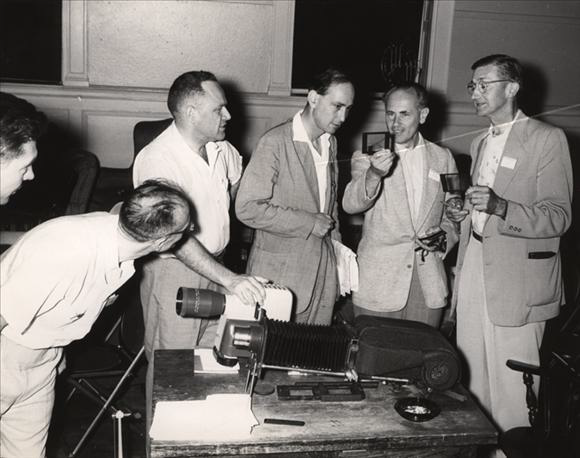X-RAY RUNS: Apply for Beamtime
2017 Nov 1 - Dec 21
2018 Feb 7 - Apr 3
2018 Proposal/BTR deadline: 12/1/17
2018 Apr 11 - Jun 4
2018 Proposal/BTR deadline: 2/1/18

Showing lantern slides at a Gordon
Conference, 1957
(Photo: www.frontiersofscience.org historical archive)
Contact: E. Fontes (ef11@cornell.edu)
The next Gordon Research Conference (GRC) on X-ray Physics will be held August 5-10, 2007 at Colby-Sawyer College in New Hampshire. With an international cast of speakers, conference participants will hear about exciting X-ray-based science at 3rd generation light sources and scientific plans and early results from 4th generation sources.
Gordon Conferences have a well-earned reputation for being a lively and fun opportunity to learn a lot about science. GRCs have grown considerably in scope and attendance over their 76-year history; this year nearly 200 different conferences will host over 20,000 attendees! Past attendees hold fond memories of these meetings because of their unique and personal flavor. GRC rules limit meetings to about 100 persons that meet together in one room twice each day. Most conferences convene at somewhat remote, mostly rural locations and the afternoons are reserved for small group “brainstorming” and recreation. Discussions and debates are not only expected, but are encouraged. Presentations and session dialogue are kept private – no written proceedings or quotations are allowed.
Held every two years since 1989, the X-ray Physics meeting this year was organized by chairman Ken Finkelstein, from the Cornell High Energy Synchrotron Source (CHESS) and vice chairman Jun'ichiro Mizuki, from SPring-8 and the Japan Atomic Energy Research Institute. They have worked to expand and encourage young scientists to join the GRC tradition. Senior graduate students, post-doctoral fellows, and scientists less than 3 years beyond the Ph.D. are eligible to apply for one of twenty $500 fellowships to help cover meeting fees. Details about the fellowships and meeting registration are available on the GRC web site (http://www.grc.org/programs.aspx?year=2007&program=xray). Fellowship applications are due March 31st and regular meeting applications are due July 1, 2007.
Topical sessions, moderators and speakers are posted on the web site. A session entitled Science Frontiers Using New X-ray Sources, moderated by H. Dosch (MPI-Stuttgart), will discuss SASE XFEL projects at Spring-8 and Hamburg. D. Reis (U. Michigan) will lead a session on Ultra-Short Pulse X-ray Science that covers light-induced dynamics in correlated-electron systems, reconstructing a molecular orbital wave function from high harmonic generation and ultrafast coherent X-ray imaging. P. Abbamonte (UIUC) is discussion leader for Frontier Applications for Soft X-rays that addresses scientific challenges, new directions, and soft X-ray diffraction from charge, spin, and orbital order.
A session on Coherence and Phase Imaging, led by Q Shen (APS), will cover X-ray lensless imaging of extended objects, imaging interfaces with phase-sensitive scattering and microscopy, and near-field scattering (speckle). In New and Novel X-ray Scattering, J. Goulon (ESRF) will moderate talks on X-ray detected magnetic resonance, nonreciprocal directional dichroism and related X-ray magnetoelectric phenomena. D. Bilderback (CHESS) is discussion leader for Materials Science with Nano-Scale Beams, which will explore multilayer Laue lens optics for nanometer focusing of hard X-rays, high-pressure science at 4th generation sources, and fluorescence analysis for environmental sciences using high-energy microfocusing. A session titled X-rays In Medicine, Life, Environmental Sciences, led by A. Bravin (ESRF), will cover diffracted X-ray tracking (DXT) for super-accurate dynamical observations of single internal biomolecular motions, diffraction enhanced imaging and Alzheimer’s disease, and comparative chemistry and anatomical plant evolution.
Finally, a session seductively called “Hot Topics” will bring to fore future directions in X-ray detection, novel results from inelastic X-ray scattering (IXS), and new optics for high-resolution IXS (principles and progress).
The GRC foundation hopes that past and future attendees will continue to celebrate their 75th year anniversary of sponsoring research conferences. To commemorate the event, the foundation has created two publications to preserve the rich history of the conferences as well as the tremendous growth of the scientific community during that period. First, the publication Reflections from the Frontiers – Explorations for the Future will be given to all GRC attendees this year. Second, the foundation has launched a web site - www.frontiersofscience.org – that archives and supplements the content of the “Reflections” publication. This site illustrates the history of the organization by offering contributed essays, photographs from past conferences, recollections, and facts and figures – most provided by nostalgic and thoughtful scientists and past attendees. Read about the 183 meetings for 2007 at http://www.grc.org and consider joining the tradition!
Full article: (pdf)
